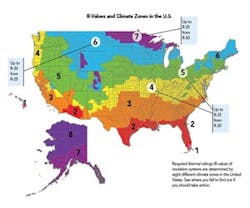Cost-Efficient Roofing Insulation for the Right Thermal Rating
An efficient roofing insulation system with the proper thermal rating enables you to maximize your investment. There are several strategies and adjustments you can use to comply with codes, some with better returns than others. Let these tips and updates guide you.
Updates on Required R-Values
“The building code prescribed R-values for above deck roof insulation will be increased again in the near future once the building code agencies adopt the 2012 ASHRAE criteria,” explains Darrell Smith, an envelope and roofing consultant with V.J. Engineering.
For climate zones 4 and 5 – a large stretch across the middle of the country – the new specified value is R-25. For zone 6, which covers much of the northern U.S., it will increase to R-30. The changes reflect ASHRAE’s aggressive goals for energy conservation.
Compliance likely requires another one or two layers of insulation. At a certain point, however, adding on more insulation results in diminishing returns.
R-value measures resistance to heat flow, while U-value (the inverse of R) represents heat flow in BTUs per hour, per square foot of area, per degree of temperature difference between the warmer and cooler sides of a construction.
As R-value is doubled with another layer of insulation, the improvements in BTUs get increasingly smaller and come at the increased cost of making the insulation thicker. “I don’t understand the rationale for requiring higher R-values,” Smith says.
Aspects of Efficient Roofing Insulation
Air leakage. Deck-to-wall connections and deck penetrations allow airflow, with heat leaking out just like water. If the roof deck is visible from the interior, it may be possible to seal these leaks with sprayed foam or self-adhesive membrane material. Heat leakage is easy to spot using infrared analysis.
Roof water leakage. All roof insulations lose R-value when wet. If the R drops from 20 to 5, all those insulation upgrades were for naught. All roof leaks must be promptly reported and repaired, not assuaged by using a larger bucket.
Condensation. Not all roof systems require vapor retarders or air barriers; however, with high internal relative humidity and cold exterior conditions, condensation results in wet insulation, just like a roof leak would.
Reflectivity and emissivity. Reflective coatings on dark-colored
membranes are beneficial, but only if they stay reflective. On a hot
day, if the dark roof is 160 degrees F., a reflective coating might be only 130 degrees F. Retention of reflectivity depends upon good substrate
preparation so the coating doesn’t flake off and requires positive
drainage so dirt, algae, and atmospheric pollutants don’t build up.
Source: Richard L. Fricklas
“We are spending more to conserve less,” adds Richard L. Fricklas, retired technical director emeritus of the Roofing Industry Educational Institute. “But since ASHRAE carefully considers its new R-values, we can learn to live with it. If we are sincere about making our roofing systems more energy-efficient, we need to take a closer look at the rest of the picture.”
Consider several smaller aspects of the insulation system for improvements, rather than just adding another layer, Fricklas recommends.
Guidelines, Tips, and Tweaks
Mechanically attaching insulation with a metal cap and fastener produces a thermal bridge that reduces the effective R-value significantly, anywhere from 3-8%, resulting in an actual R-value that is far less than the code requires and what you think you’re getting, Smith says.
Fasten with adhesive or bitumen where possible. Where it isn’t – like on a steel deck – mechanically fasten only the first layer of insulation, then use adhesion on top of that, Smith advises.
“That’s a good practice to follow,” he adds. “I don’t think the concept of a thermal bridge causing loss is common knowledge.”
Other factors to consider include condensation, reflectivity of the roof, and air and water leakage. See sidebar for details.
With increased thermal requirements, insulation systems represent a greater investment, and it needs to be protected.
“We are reaching or have exceeded the economic limit on the benefits of increased thermal insulation,” Fricklas says. “We need to be far more conscious of the entire system if we are to save energy or money, or both.”
Chris Curtland ([email protected]) is assistant editor of BUILDINGS.
